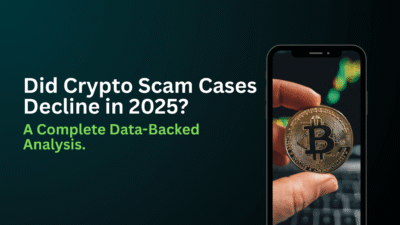
Crypto Address Poisoning: How to Avoid It?

With the growing number of crypto users, hackers seek new ways to steal money. Cybercriminals use crypto address poisoning attacks to redirect traffic, interrupt services, and access sensitive data. They do this by inserting fake data or changing routing tables. These attacks exploit network protocol flaws, seriously threatening data integrity and security.
This article provides everything you need to know about crypto address poisoning attacks and how to prevent them.
What is Crypto Address Poisoning Attacks?
Crypto Address poisoning attacks are when hackers mess with cryptocurrency addresses. They do this to deceive people and steal their money.
Crypto addresses are unique alphanumeric characters on a blockchain network that serve a transaction source or destination. Crypto address poisoning is a way where criminals use several methods to undermine teh security and integrity of crypto transactions and wallets.
These attacks are mostly used to illegally steal cryptocurrencies, or disrupt the efficiency and security of a blockchain network.
Crypto address poisoning attacks include:
- Robbery
Attackers often trick the transmission of funds to malicious crypto addresses. This involves strategies such as transaction interception, phishing, or address manipulation.
- Disruption of Blockchain Networks
Crypto poisoning attacks are often used to disrupt the normal operations of a blockchain network. The attackers use delays, congestion, or interruption in transactions. Sometimes it also affects the smart contracts causing disruption in the entire network.
- Fraud
The cybercriminals often deceive the users by sending similar and well-known figures. This compromises the community’s trust in the network. Therefore, resulting in confusion among users.
Therefore, it has become crucial to protect the integrity of the blockchain network and the cryptocurrencies. The crypto address poisoning attacks highlight the importance of strict security processes and attention within the crypto ecosystem.
What are the Types of Crypto Address Poisoning Attacks?
There are several ways scammers can try crypto address poisoning attacks. These are transaction interception, phishing attacks, Sybil attacks, address reuse exploitation, smart contract vulnerabilities, address spoofing, and fake QR codes. Each of these attacks risks the blockchain integrity and the digital assets of the users.
- Phishing Attacks
In the world of cryptocurrencies, phishing attacks are the most common type of address poisoning. It involves cybercriminals creating and building phony emails, websites, or communications. Moreover, they look like or resemble reputable wallet providers or exchanges.
These platforms trick users into disclosing their login credentials, mnemonic phrases, or private keys. Once the criminals get the information, they conduct criminal activities and get access to the unauthorized cryptocurrencies of the users.
- Transaction Blocking/Interception
Attackers may use transaction interception to poison addresses. It might involve intercepting legitimate cryptocurrency transactions and modifying the destination address. Moreover, they change the recipient address to their own, redirecting the funds to their wallet instead of the intended recipient. Malware that infects the user’s device or network is often used to execute these attacks. Thus, allowing the attacker to gain control and manipulate transaction details.
- Address Repetition
It is important to avoid repeating blockchain addresses as hackers can exploit this security risk. Reusing an address could expose its transaction history and vulnerabilities. Thereafter, potentially leads to unauthorized access and theft of funds by malicious actors.
- Crypto Address Poisoning: Sybil Attacks
In proof-of-stake (PoS) blockchain networks, cybercriminals may exploit Sybil attacks. They create fraudulent nodes to gain control over the network’s functioning. Thereafter, this control is used to manipulate data, deceive users, and compromise the network’s security. As a result, it’s crucial for the cryptocurrency ecosystem to maintain strict security measures. Moreover, remain vigilant to prevent such attacks. Especially, as it can impact the consensus mechanism, modify transactions, and potentially lead to the double-spending of cryptocurrencies.
- Fake QR Codes
Cybercriminals can use address poisoning attacks to deceive unsuspecting users into sending cryptocurrency to a fraudulent location. This can occur through the distribution of bogus payment addresses or QR codes, often in physical form.
- Address Spoofing
One type of crypto address poisoning attack is address spoofing. This is where attackers create counterfeit cryptocurrency addresses that closely resemble legitimate ones. Moreover, the intention is to trick users into transferring funds to the attacker’s address instead of the intended recipient’s address. Thereafter, the fake address is designed to look like the real one. Moreover, it makes it difficult for users to distinguish between the two.
- Smart Contract Exposure
Attackers take advantage of vulnerabilities in decentralized applications (DApps) or smart contracts on blockchain systems to carry out address-poisoning attacks. Thereafter, these attacks alter the transaction process and redirect funds or cause unintended actions within the contract. As a result, users may suffer financial losses, and decentralized finance (DeFi) services may be disrupted.

What Happens in Crypto Address Poisoning Attacks?
Address poisoning attacks are a significant threat to both individual users and the stability of blockchain networks. Victims can suffer financial losses when attackers steal their crypto holdings or alter transactions to redirect funds to their wallets. Such fraudulent schemes can erode users’ trust in the security and reliability of blockchain networks and services.
Moreover, Sybil attacks or exploiting smart contract vulnerabilities can disrupt the normal functioning of blockchain networks, leading to congestion, delays, or unintended consequences that can impact the entire ecosystem. To mitigate the risks of address poisoning attacks, robust security controls and user education are necessary in the crypto ecosystem. It is crucial to ensure the security and integrity of the blockchain network.
Also Read: India to Launch Cryptocurrency Intelligence and Analysis Tool (CIAT) to Combat Cyber Fraud
How to Avoid Address Poisoning Attacks in Crypto Realms?
To ensure the protection of digital assets and uphold the security of blockchain networks, it is crucial to implement measures that can prevent address poisoning attacks in the cryptocurrency ecosystem. To avoid becoming a victim of these attacks, one can take the following steps:
- Use a New Crypto Address
To improve protection against address poisoning attacks, it is recommended to generate a new crypto wallet address for each transaction. Hierarchical deterministic (HD) wallets can automatically create new addresses for every transaction, reducing the predictability of addresses and making it harder for attackers to redirect funds. The wallet’s automatic address rotation feature enhances a user’s safety against address poisoning attacks by making it more challenging for hackers to intercept or manipulate transactions.
- Avoid Crypto Address Poisoning Using Hardware Wallets
In comparison to software wallets, hardware wallets are a secure alternative. Since the private keys are offline, they reduce your risk of theft.
- Disclose Your Crypto Address With Caution
To maintain privacy and security, individuals should exercise caution and refrain from disclosing their crypto addresses publicly, especially on social media platforms. Therefore, it is best to use pseudonyms or other anonymous identities instead.
- Look for Renowned Reputable Wallets
To protect oneself from crypto address poisoning and other attacks, it is crucial to opt for reputable wallet providers that are recognized for their sturdy security features and frequent software updates.
- Update Your Wallet
To ensure protection against address poisoning attacks, it is crucial to keep your wallet software up to date with the latest security fixes.
- Use Whitelisting
One way to safeguard your digital assets is by using whitelisting to restrict transactions to trusted sources. Some wallets and services allow you to whitelist certain addresses to send funds to your wallet. Therefore, this can help prevent unauthorized transactions and ensure the security of your assets.
- Multisignature Wallets
Multisignature wallets, also known as multi-sig wallets, require multiple private keys to authorize a transaction. This additional layer of security can help safeguard against unauthorized access and provide users with added peace of mind.
- Blockchain Analysis Tools
Analysts can use blockchain analysis tools to detect and investigate suspicious activities, like crypto address poisoning. A common practice they can monitor is dusting, where small amounts of cryptocurrency (dust) are sent to multiple addresses. Therefore, this results in unspent transaction outputs (UTXOs) with tiny amounts of crypto. Therefore, by tracking these dust trade patterns and identifying UTXOs linked to dust transactions, analysts can potentially uncover addresses that have been targeted for poisoning.
Looking Forward
If someone suspects a crypto address poisoning attack, it is important to contact their crypto wallet provider through official support channels and report the incident. Additionally, it is advisable to report the occurrence to relevant law enforcement or regulatory authorities for further investigation and potential legal action if the attack caused significant financial harm or had malicious intent. Timely reporting is crucial in reducing potential risks and protecting both individual and group interests in the cryptocurrency ecosystem.





Leave A Comment